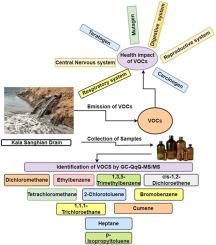印度旁遮普Kala Sanghian排水沟存在有害挥发性有机化合物的调查研究和风险评估
IF 3.7
2区 环境科学与生态学
Q2 ENVIRONMENTAL SCIENCES
引用次数: 0
摘要
印度旁遮普的kala Sanghian排水系统接收来自皮革工业、电机轴承工业、电镀工业和纺织工业的化学物质。这种排放成为生理障碍的来源,如皮肤疾病、呼吸问题、周围神经病变和附近社区的神经症状。这些也成为致癌和诱变剂的温床。方法采用气相色谱-三重四极杆质谱联用技术(GC-QqQ-MS/MS)对卡拉桑吉安排水工业废水中有毒挥发性有机物的含量进行分析。沿着排水沟的四个地点都是工业中心,被选中用于收集样本。样品一式三份采集。结果在卡拉桑吉安排水(KSD)的4个站点(LO、LD、FD和BD)中检出了6种挥发性有机物。鉴定出的挥发性有机化合物有1,3,5 -三甲苯、对异丙基甲苯、溴苯、异丙烯、乙苯、四氯化碳、顺- 1,2 -二氯乙烯、庚烷、二氯甲烷、1,1,1 -三氯乙烷和四氯甲烷。最常见的挥发性有机化合物是庚烷、二氯甲烷和顺式- 1,2 -二氯乙烯。挥发性有机物含量最高的是Site 3 (FD),有8种有机物。鉴定出庚烷的总浓度最高,为619.3 ng/ml。相反,cumene的浓度最低,为10.11 ng/ml。经鉴定的挥发性有机化合物属于苯系化合物、氯化烃、氯化苯和烷烃。工业化和城市化是环境,特别是水体中污染物的巨大来源。发展中国家严重污染的排水沟正在损害水体的正常参数。在研究地点,有害化学物质被排放到排水沟中,没有空气监测。这些有毒化合物不仅对居民造成危害,而且还操纵着水生生物和农业部门。萨特莱吉河和海洋是这种外流的下一个目的地。从这个意义上说,它直接或间接地影响着全世界的水生生物和人类生活。我们的研究强调了环境监测对保护人类生命的重要性。本文章由计算机程序翻译,如有差异,请以英文原文为准。

An investigatory study and risk assessment for the existence of hazardous volatile organic compounds in Kala Sanghian Drain, Punjab, India
Background
Kala Sanghian Drain, Punjab, India, receives the chemicals from the leather industries, motor bearings industries, electroplating industries, and textile industries situated on its side. This drain becomes a source of physiological disturbance, such as skin diseases, respiratory problems, peripheral neuropathy, and neurotic symptoms in the community living near it. These become a bed of carcinogenic and mutagenic agents, too.
Methods
To analyze the presence of toxic volatile organic compounds in the industrial effluent of Kala Sanghian Drain, gas chromatography equipped with triple quadrupole mass spectrometry (GC-QqQ-MS/MS) was used. The four sites along the length of the drain, having a hub of industries, were chosen for the collection of samples. The samples were collected in triplicate.
Results
Eleven volatile organic compounds have been detected from four sites (LO, LD, FD, and BD) of the Kala Sanghian Drain (KSD). The identified volatile organic compounds were 1, 3, 5-Trimethylbenzene, p-isopropyltoluene, bromobenzene, cumene, ethylbenzene, carbon tetrachloride, cis-1, 2-dichloroethene, heptane, dichloromethane, 1, 1, 1-trichloroethane, and tetrachloromethane. The most frequently occurring volatile organic compounds across the sites were heptane, dichloromethane, and cis-1, 2-dichloroethene. The highest number of volatile organic compounds was observed in Site 3 (FD) with eight organic compounds. Heptane was identified with the highest total concentration of 619.3 ng/ml. On the contrary, cumene was present with the lowest concentration of 10.11 ng/ml. The identified volatile organic compounds belong to the benzene series, chlorinated hydrocarbons, chlorinated benzene, and alkane.
Public health relevance
Industrialization and urbanization are colossal sources of pollutants in the environment, especially in water bodies. The highly polluted drains of developing countries are impairing the normal parameters of the water bodies. At the study site, where the hazardous chemicals are released into the drain, there is no air monitoring. These toxic compounds not only become a hazard for the residents but also manipulate the aquatic life and the agriculture sector. The Sutlej River and the ocean are the next destinations for this outflow. In this sense, it affects aquatic and human life worldwide, either directly or indirectly. Our research emphasizes how important environmental monitoring is to preserving human life.
求助全文
通过发布文献求助,成功后即可免费获取论文全文。
去求助
来源期刊

Atmospheric Environment
环境科学-环境科学
CiteScore
9.40
自引率
8.00%
发文量
458
审稿时长
53 days
期刊介绍:
Atmospheric Environment has an open access mirror journal Atmospheric Environment: X, sharing the same aims and scope, editorial team, submission system and rigorous peer review.
Atmospheric Environment is the international journal for scientists in different disciplines related to atmospheric composition and its impacts. The journal publishes scientific articles with atmospheric relevance of emissions and depositions of gaseous and particulate compounds, chemical processes and physical effects in the atmosphere, as well as impacts of the changing atmospheric composition on human health, air quality, climate change, and ecosystems.
 求助内容:
求助内容: 应助结果提醒方式:
应助结果提醒方式:


